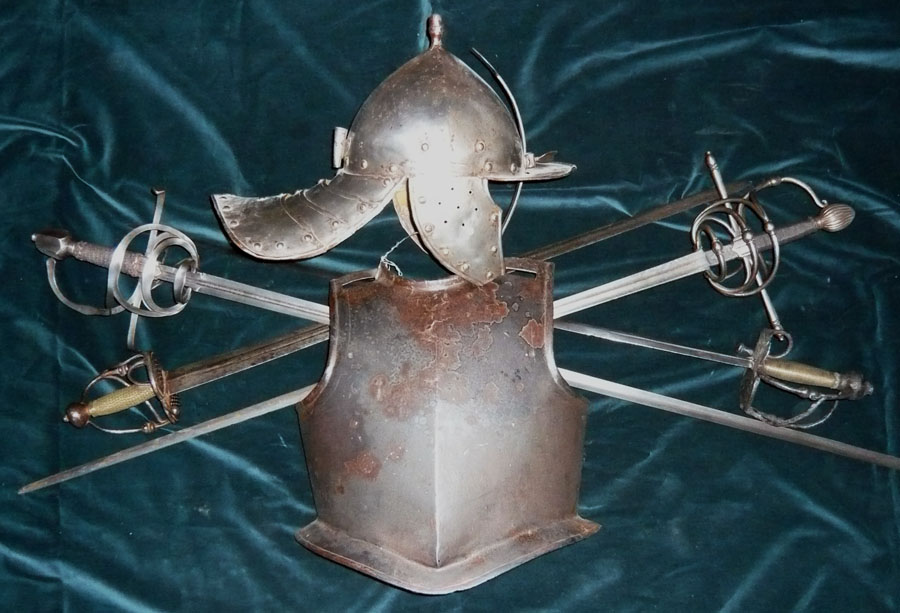Danish/Norwegian arms
Denmark & Norway were in a union for 430 years through a Norwegian king marrying a Danish Princess and then “being died” – leaving a son that conveniently also (was) died at an age of 17. Norway became the following Danish king’s major source of income through taxes – and also his main source of fighting men that were not controlled by the Danish nobility. Read more about the History of Norway with a possibly slight twist.
Already around year 850 – just after the start of the Viking age – the leidangen (leiðangr) was established as a defense and later also offense force (the vikings) along the Norwegian coast. Leidangen was a tax all free men (farmers) had to pay. By the second half of the 900’s Norway was divided info several hundred skipreider – covering the whole coast and the rivers as far as the salmon came. The farmers at each reid were to build and equip a ship, the size defined by a number of oars. In the beginning it was 40 oars, but over time more were added.
A Viking sword and a viking type axe (but made and used in the 1600’s)
The arms used, were bows, spears, swords and axes. The latter two are the ones most renown from the viking age. Shields were used fror protection and for decoration on the boats. The picture shows a viking sword from about year 1000 + the typical viking axe that was in use as late at in the 1700’s. The one on the picture above is from about 1640 with a handle from the 1800’s.
The leidangen tax was paid until the 1800’s, but leidangen in reality sized to exist in the early 1600’s when King Christian IV wrote Den norske lov in 1604 – much of it the same at Magnus Lagabøters law from 1274.
This law demanded the farmer to be armed according to the wealth of the farm. The poorest farmers could have a pike. Some farmers a sword or an axe – or both – even with a gun as well if the farm was a bit larger. And four and four of the richest farmers should join up and pay for a full time soldier equipped with horse, arms and full equipment. A total of 8000 second hand swords called tessak (probably produced in South-Eastern Europe in the middle of the 16. century) were bought and sold to the Norwegian farmers.
Tessak swords and the Norwegian farmer’s fighting axe from the first half of the 1600’s
Now the Danish king had a well equipped Norwegian army that cost him next to nothing and that he and not the Danish nobility controlled. Leidgangen was still in operation as a defense system at the time and would more or less be for the next 150 years. It should take another 50 years before Norway started getting a professional army.
Army weapons from the 1600’s – Breastplate, lobster-tail helmet, rapiers for the officers and Schwedendegen for the enlisted men
By the mid 1600’s a number of border fortresses towards Sweden were being built and these were manned by officers and regular soldiers Nasjonale Festningsverk. (There is a lot of interesting history under each fortress in the link, but only in Norwegian.) By 1760 most of the fortresses were completed – this was the beginning of a regular Norwegian army.

Throughout the 17. century and in the beginning of the 18. most firearms for the army were bought in Germany and Holland. There was a limited production in Denmark and also in Norway. A musket used in Oppdal in the late 1600s was probably “all Norwegian”. Some hilts for edged weapons were bought abroad until 1750, but the blades were Danish. After about 1750 just about all fire-arms and edged weapons used in Norway were produced in Denmark, with a few exceptions made in Norway, until the union was dissolved in 1813.
The first DkN weapon with a model year, is the M1701 soldatkorde. There is a slight problem with this, as a number of them have C5 (Christian V) on the blade and he died in 1699. The M1711 skiløperrifle was probably also produced in the 1690’s. Weapons after this have a somewhat more correct model year. These pages will eventually cover most of the main models in the Danish-Norwegian army & navy, with the exception of the French arms Denmark received after 1808.
One very interesting detail is that from the mid 1700’s Denmark got “all the new stuff” and Norway got the leftovers. As a result, Norway still has a lot more Danish military long-guns from the 18. century than Denmark has.
Please find the different models under the tabs. If you have questions regarding Norwegian small-arms and edged weapons, please mail me at .


